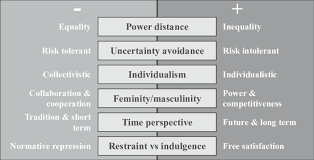Hofstede's Cultural Dimensions - Explained
What are Hofstede's Cultural Dimensions?
- Marketing, Advertising, Sales & PR
- Accounting, Taxation, and Reporting
- Professionalism & Career Development
-
Law, Transactions, & Risk Management
Government, Legal System, Administrative Law, & Constitutional Law Legal Disputes - Civil & Criminal Law Agency Law HR, Employment, Labor, & Discrimination Business Entities, Corporate Governance & Ownership Business Transactions, Antitrust, & Securities Law Real Estate, Personal, & Intellectual Property Commercial Law: Contract, Payments, Security Interests, & Bankruptcy Consumer Protection Insurance & Risk Management Immigration Law Environmental Protection Law Inheritance, Estates, and Trusts
- Business Management & Operations
- Economics, Finance, & Analytics
What is Hofstede's Framework?
Hofstede's Cultural Dimensions Theory is a framework for cross-cultural communications. The framework seeks to demonstrate the effects of a society's culture on the values of members of the culture and their behavior.

The theory proposes six dimensions through which cultural values can be analyzed:
- Individualistic vs Collectivistic
- High vs Low Power Distance (strength of social hierarchy)
- High vs Low Uncertainty Avoidance
- Masculinity-Femininity (Task Orientation vs Person Orientation)
- Long-Term vs Short-Term Orientation
- Indulgence vs Self-Restraint
Researchers assess individual cultures on each dimension on a scale of 1-100. This allows for comparison of cultures based upon the individual dimensional scores.